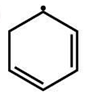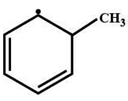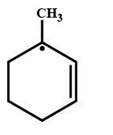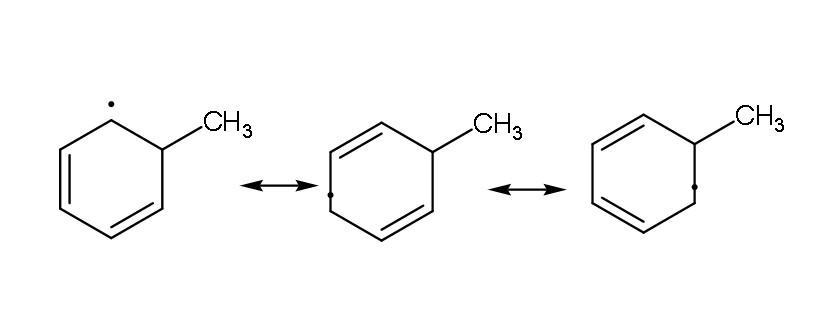
Least stable radical among the following is:
(A)

(B)

(C)

(D)





Answer
548.4k+ views
Hint In order to solve this problem, we need to have an idea about free radicals and then about the stability of free radicals. An atom or group which belong to the same or different elements that behave as a single unit and possess a negative or positive charge is known as a free radical.
Complete step by step solution:
- As we know , the free radical reactions work through homolytic cleavage – that is, the bonds break such that equal numbers of electrons are distributed to each atom and the resulting species are called free radicals.
- As in the case of carbocations, free radicals also are electron-deficient species and the stability of radicals depend on various factors The radicals can be stabilized by the donation of electrons by neighbours and for this reason, the radical stability will increase in the order of methyl < primary < secondary < tertiary.
- Another important factor which determines the stability of radicals will be delocalization. Or in other words the free radicals are stabilized by resonance. As we can observe in option (B) , there is an extended resonance as shown below

Therefore, the least stable radical will be option (B).
Note: Keep in mind that the free radicals are destabilized by the removal of electron density, and the stability decreases with the increase in s-character of the orbital and the radical stability will decrease with increasing electronegativity of the atom and reduces with a decrease in polarity.
Complete step by step solution:
- As we know , the free radical reactions work through homolytic cleavage – that is, the bonds break such that equal numbers of electrons are distributed to each atom and the resulting species are called free radicals.
- As in the case of carbocations, free radicals also are electron-deficient species and the stability of radicals depend on various factors The radicals can be stabilized by the donation of electrons by neighbours and for this reason, the radical stability will increase in the order of methyl < primary < secondary < tertiary.
- Another important factor which determines the stability of radicals will be delocalization. Or in other words the free radicals are stabilized by resonance. As we can observe in option (B) , there is an extended resonance as shown below

Therefore, the least stable radical will be option (B).
Note: Keep in mind that the free radicals are destabilized by the removal of electron density, and the stability decreases with the increase in s-character of the orbital and the radical stability will decrease with increasing electronegativity of the atom and reduces with a decrease in polarity.
Recently Updated Pages
Why are manures considered better than fertilizers class 11 biology CBSE

Find the coordinates of the midpoint of the line segment class 11 maths CBSE

Distinguish between static friction limiting friction class 11 physics CBSE

The Chairman of the constituent Assembly was A Jawaharlal class 11 social science CBSE

The first National Commission on Labour NCL submitted class 11 social science CBSE

Number of all subshell of n + l 7 is A 4 B 5 C 6 D class 11 chemistry CBSE

Trending doubts
10 examples of friction in our daily life

One Metric ton is equal to kg A 10000 B 1000 C 100 class 11 physics CBSE

Difference Between Prokaryotic Cells and Eukaryotic Cells

1 Quintal is equal to a 110 kg b 10 kg c 100kg d 1000 class 11 physics CBSE

State the laws of reflection of light

Explain zero factorial class 11 maths CBSE




